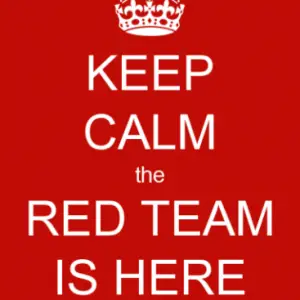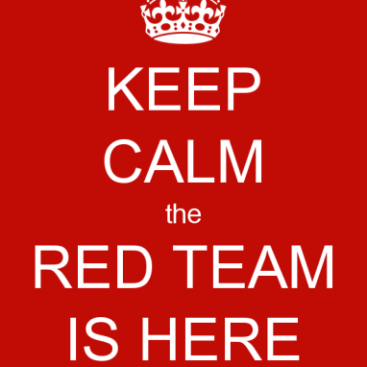This is a Guest Post by Alex @MacroOps which was posted originally here: Why you need to Red Team Everything and is reposted here with permission.
Have you ever had an investment idea that you just knew was going to be a slam-dunk and make you a ton of money? So you put on a large position, maybe your whole nut, because why not… right? It’s a sure thing!
And you’re the genius who discovered it! Now you’re gonna ride this sucker all the way to the moon while leveraged to the tits.
You’re already asking for top shelf margaritas because your future profits are as good as in the bank. Dammit you deserve to treat yourself for all your hard work in the markets!
There’s not any possible downside to this trade. Those who say otherwise are dismissed with heartfelt sympathy for their lack of vision. Those poor fools….
Then… suddenly… the unthinkable happens. At least it’s unthinkable to you because you couldn’t conceive of such a thing.
The trade goes south.
At first you tell yourself it’s just a quick shakeout before the big move. The big money is just trying to scare off the weak hands and suckers before this thing launches on its way.
But then the stock falls a little bit further. And then a bit further again. And then even more.
You try and rationalize this away. At this point, after all your cheerleading, your very pride is tied to the outcome. You must be proven right!
So you double-down on your research and examine the company with a fine tooth comb. What do you discover? That the trade is still fantastic! Vindication! The fundamentals are all there. And if anything , the company is now just selling for a huge discount. So the market is clearly wrong and you will eventually be proven right.
So you hang in there, maybe even add to your position just to show how confident you are in your sound logic. You’re not scared, you’re a damn investing hero — standing up for what you believe is right!
And then…devastation. Total, utter devastation and despair. The stock has cratered. Down is up and black is white and you think the whole world has gone mad — or at least the market anyways. You don’t know what to do. You are in the hole and can’t afford to take such a massive loss. You believe the stock has to come back… it just has to!! At this point you’re doing mental gymnastics that even Larissa Latynina would envy.
You can’t and won’t accept this reality. You’re gonna hang in there and wait for the stock to comeback. Besides, it’s only a paper loss not a “real” one.
And then you change your trading timeframe. You convince yourself you’re Warren Buffett. You plan on hanging onto the investment for years. Heck, maybe even a decade! It’s a great company and you want to be a partial owner of those cash flows and… yada yada yada.
Acceptance. Finally the 5th stage of loss sets in and you’re forced to take your medicine. You can’t afford to stay in the position. You realize that you’re not the Oracle of Ohama after all. The idea of holding the investment for a decade was ridiculous!
Maybe you even start noticing a bunch of holes in your original thesis to buy that crappy stock. In fact, now that company’s flaws and shortcomings are obvious! You hate that stock and don’t know what the hell you were ever thinking in buying the damn thing.
Does any of this sound familiar? It’s an extreme example, but one I’ve seen play out to varying degrees time and time again.
Fortunately, there are many ways you can prevent this costly emotional roller coaster. We’re going to talk about one of the more important ones today. And that is the practice of “Red Teaming”.
To Red Team something is to take people who are not wedded to a plan and ask them to defeat or disrupt it. It’s a logic exercise conducted to expose the weaknesses of a plan or idea. The hope is that the “planner” can then make the idea stronger and more robust.
This practice is used extensively in the military. I used to use it all the time when planning missions as a sniper. I also used it when I worked in intelligence to help leaders coordinate at the strategic level.
This is how it works. Say I had a mission to hit a house and take down or capture a specific target in a populated city. I would come up with a detailed plan. In this plan I would cover everything. The route, the men I would take, what equipment we’d need and a host of contingencies if sheep dung hit the fan.
I would then grab a couple of other team leaders who weren’t involved in the mission and ask them to Red Team my plan. They would think of possible enemy actions, civilian reactions to our presence on the ground, and much more. Basically they would just think of logical “What If’s” to try and disrupt my plan.
This accomplished many things:
- It brought fresh eyes to the problem. This would almost always reveal an element or possibility I hadn’t thought of.
- It would strengthen my plan or result in a new one. This would happen after finding out the initial plan was bunk or that there was a better way of doing things.
- It forced everyone to get outside themselves and think about the problem from multiple points of view. This is beneficial for any type of task that involves creativity.
In a recent interview, General Stanley McCrystal told an interesting story about a retired General who helped Red Team the Iraq invasion. This General surprised everyone by taking his Iraqi forces and going on the offensive. He immediately attacked the US troops in Kuwait and destroyed their ports. At first the planners whined “You can’t do that!” To this the General replied “why not? It worked… didn’t it?”.
Nobody ever thought of the possibility that Saddam would attack first. It just wasn’t in their universe.
These smart and capable planners, who believed they thought of everything, were completely blindsided by this move. As a result, the invasion plan was largely altered to account for this possibility.
How can we apply this to investing?
Well it’s mostly about changing your mental approach to trade analysis. Humans have an instinctive tendency to fall in love with their own ideas. This makes them either dismissive or oblivious to their ideas’ shortcomings. This is an expensive tendency to have in trading. We need to flip the script.
Paul Tudor Jones (PTJ) — a trader we look up to and admire — said in his Market Wizards interview (emphasis ours):
The most important rule of trading is to play great defense, not great offense. Every day I assumed every position I have is wrong. I know where my stop risk points are going to be. I do that so I can define my maximum possible drawdown. Hopefully, I spend the rest of the day enjoying positions that are going in my direction. If they are going against me, then I have a game plan for getting out.
I also remember reading about a hedge fund manager in Drobny’s Invisible Hands (an excellent book by the way) who would not only stress-test against every conceivable scenario, but would even war-game ridiculous scenarios like “what would happen to the markets and this portfolio if aliens were to invade earth?” Now I’m not saying you need a portfolio contingency plan for when the zombie apocalypse happens. I’m just saying you need to Red Team the shit out of your trade ideas, portfolio construction, and methodology.
This works best if you have knowledgeable people who can help you. In fact, this is one of the greatest benefits to being a part of the Foundation community. We foster this kind of interaction by actively promoting our ideas to our community to be ruthlessly dissected and critiqued. We also help our members Red Team the hell out of their own ideas.
We don’t nurture ego’s here. We focus on preserving capital and making a return. Ego has no helping role. We want brutal honesty. It helps us not only stay alive, but thrive in the markets.
If you don’t have others to Red Team your ideas, you can still do it yourself. You need to adopt this kind of thinking anyway. Objectivity is your guiding principle. You need to be like Spock, a detached emotionless son of a gun who never falls in love with his own ideas.
Like PTJ, you need to start every day assuming that every position you have is wrong. You need to be actively looking for reasons to cut your positions. This is your capital being risked after all… and you don’t risk your money for just any average trade!
Every trade, even the best ones, have their weaknesses. Find them. There will always be unknown unknowns in the markets. There is nothing we can do about this. But the more we make ourselves aware of possible risk, the better we can plan and react to those risks when they occur.
You should have solid “if this, then that” statements for all types of contingencies. After all, trading and investing is all about protecting your downside by managing risk. So start Red Teaming the hell out of your theses!

